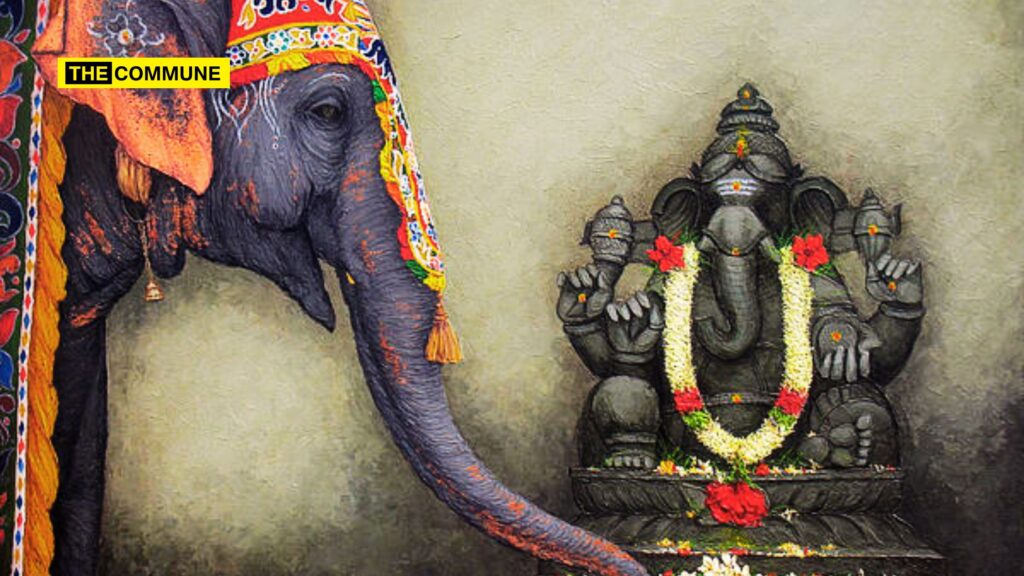One of the simplest but yet a towering God in the Hindu pantheon is Vinayagar or Ganesha. He is celebrated not just across the lengths and breadths of India, that is Bharat, but is revered as far as Japan. He can be found adjacent to a stream of river under a banyan tree and also as Siddhi Vinayak at the bustling suburb of Dadar in Mumbai. He can be prayed to by just molding wet turmeric paste or by getting an elaborate clay mold. Ganesha or Vinayagar is not just a God but is personalized as a buddy to many, to whom people go whenever they find themselves in trouble. That’s why before commencing any auspicious work, it is Ganesh who is invoked first, because his name ‘Vinayagar’ means the remover of obstacles.
To understand the symbolism of Ganesha as the elephant- headed God, we will have to explore the elephant family in itself. Mammoths are hairy extinct mammals of the elephant family with very long tusks that curve upward. The etymology behind the word Mammoth comes from the Russian language that literally translates to Earth.
The symbolism of Ganesha’s elephant head is intriguing. Elephants, as mammals, share certain biological traits with humans, including mammary glands for milk production. However, the choice of an elephant head over a human one in Ganesha’s depiction may be attributed to the unique nature of elephant brains. Elephant brains are significantly larger and more complex than those of humans, containing three times as many neurons. Their pyramidal neurons have distinct structures, resembling long-legged spiders with few branches, which sets them apart from other mammals, including humans. Elephants do indeed exhibit remarkable behaviors, such as their ability to identify languages, mimic human voices, and possess an extraordinary memory. These qualities further emphasize the significance of Ganesha’s elephant-headed representation in Hindu mythology. This intricate symbolism highlights Ganesha’s exceptional wisdom and intellect in Hindu mythology.
The elephants have extraordinary behaviours like identifying languages, mimic human voices and also an extraordinary memory. A song by Papanasam Sivan goes like this
mUlAdhAra mUrti gaja |
mukhane sharanam unadhu ubhaya caraNamOh, embodiment of the root chakra (root cause), Oh, elephant faced I seek your refuge (I bow to your feet), I seek your refuge you with eagerness.
In the realm of yoga and spirituality, Ganesha is associated with the Mooladhara Chakra, also known as the root chakra, which is often depicted with four petals and associated with the color red. The Kundalini energy or the serpentine energy is set to reside in this chakra. This chakra is believed to be the residence of Kundalini energy, often symbolized as a serpent. The connection between Ganesha and the number four, as seen in Ganesh Chaturthi (the fourth day of the lunar month), underscores his connection to this chakra.Ganesh Chaturthi as the name suggests explains that Ganesha has a lot of connection with the number 4.
Ganesha can also be seen as a symbol of national unity because Bal Gangadhar Tilak, one of the leaders of Indian National Movement invoked Ganesha as the icon of nationalistic movement. But centuries before, Chhatrapati Shivaji Maharaj, founder of the
Maratha empire, began celebrating Ganesha, since he was the Kuladevta (family God) of the Peshwa Empire.
May this Ganesh Chaturthi indeed bring immense joy, wisdom, and abundance to our lives, drawing upon the symbolism and spiritual significance associated with Lord Ganesha.
Shruthee MS is a masters student at Vethathiri Maharishi College of Yoga, Thiruvanmayur.
Click here to subscribe to The Commune on Telegram and get the best stories of the day delivered to you personally.

